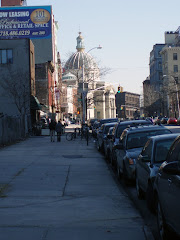Williamsburg has an historic/literary site and an actual historic district, even if it is barely a block long. And I don't mean the Domino Sugar factory.
Henry Miller, probably acclaimed and reviled in equal measure, lived on Driggs Ave. as a child. His childhood home still stands, somewhat isolated, between Grand Street and Metropolitan Avenue, with a grass off-street parking lot on one side and a marble and granite storage yard on the other.
 Henry Miller's childhood home, 662 Driggs Ave., Williamsburg
Henry Miller's childhood home, 662 Driggs Ave., WilliamsburgIn his writings he was said to have described being enchanted by Fillmore Place, a short block of row houses that runs between Driggs Ave. and Roebling St. around fifty feet or so south of his home.
 Fillmore Place from Driggs Ave. to Roebling St.
Fillmore Place from Driggs Ave. to Roebling St.I read a few years ago that there was an application before the city to have Fillmore Place declared an historic district and I have to confess that I thought it was a joke. It turns out that the laugh is on me because a little over a year ago, without much fanfare that I can remember, Fillmore Place was declared a city historic district.
 Fillmore Place, north side from Roebling St. to Driggs Ave.
Fillmore Place, north side from Roebling St. to Driggs Ave.It is said that the houses all date from the 1850s when Williamsburg was just starting to change from a "rural village to an urban neighborhood." That's another indication of just how wrong the city map on nyc.gov is in it's building information, since it claims that all the buildings there date from 1899 except for one or two that were built in 1915 and 1920.
 Fillmore Place, south side from Roebling Street to Driggs Ave.
Fillmore Place, south side from Roebling Street to Driggs Ave.So, I raise my Corona in a toast to Henry Miller, Millard Fillmore, and his place. It's probably the most respect that accidental, pro-slavery president has gotten since his death.
 Fillmore Place near the corner of Driggs Ave.
Fillmore Place near the corner of Driggs Ave.

No comments:
Post a Comment